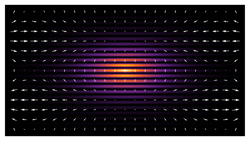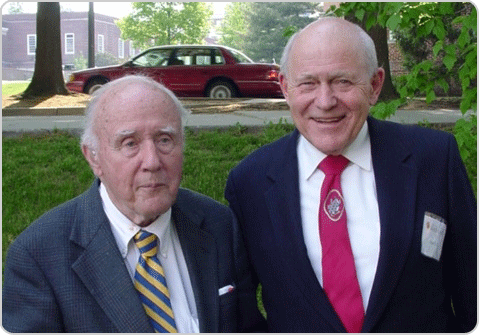- Details
-
Category: Research News
-
Published: Wednesday, November 30 2011 10:12

Researchers now have the ability to construct increasingly complex artificial quantum systems, with profound implications for science and technology. In recent work, researchers at the University of Maryland and the Laboratory for Physical Sciences explore the possibility of a new, man-made, quantum object: a hybridization of a localized, long-lived phonon (a quantum of sound) and a matter excitation. That this is possible is not obvious. Analogous to the case of cavity-QED where a photon can strongly couple with a matter excitation and become a polariton (a half-light, half-matter quasiparticle), here a phonon in a crystal plays the part of the photon. Presented in the December 2nd issue of Physical Review Letters ("Sound-based analogue of cavity quantum electrodynamics"), Soykal et al. show that similar hybrid objects based on sound and matter, dubbed "phonitons", are possible as well. The phoniton can augment existing tools to manipulate quantized vibrations in nanoscale mechanical systems, help us further understand the nature of sound and heat at the quantum level, and serve as a base component in new macroscopic artificial quantum systems.
The study of the strong interaction of light and matter at the quantum level, collectively known as cavity quantum electrodynamics, has been a prominent area of study since the 1980's. In the canonical system, an atom couples with a photon trapped between two mirrors. This effect can also occur in materials, where a photon trapped in a cavity can join with an atomic excitation and form a new quasiparticle. These photon/matter hybrid objects are typically called polaritons. Cavity-QED and polaritonics have become tools for exploring and harnessing quantum physics with many applications, from entangling distant qubits to simulating quantum systems. UMD postdoctoral fellows Rusko Ruskov and Oney Soykal in the group of Charles Tahan, at the Laboratory for Physical Sciences, have explored how to replicate this effect with sound instead of light in a solid-state system. The task is difficult because sound at the quantum level (a phonon) is a collective excitation itself --- dependent on it's host material --- and is generally harder to control and less robust than a photon. Soykal et al. provide theoretical verification that this effect is possible in a silicon system, compatible with present-day nanoscale fabrication techniques.
The key to this new system is knowledge of the unique properties of impurity atoms in silicon and the potential for high-quality, silicon-based mechanical devices. To make a high quality phonon cavity to trap a single phonon one generally needs long-wavelength acoustic phonons (even in perfect quality silicon) - which are much larger than the lattice constant. Yet most transitions of impurity "atoms" in silicon are high in energy, leading to phonon transitions with wavelengths that are too short. Soykal et al. have utilized a transition unique to silicon donors, called a valley state, that has a wavelength both amenable to high-Q phonon cavities and strong phonon-impurity coupling.
The impurity atoms in silicon that form the levels of the "atom" need to be driven only by phonons (not photons), and interact strongly with them, to form the new quantum hybrid particle. The Letter shows theoretically that in certain parameter regimes, robust phonon-matter coupling is possible. In analogy with polaritons, the authors call this new object a "phoniton" (from the greek "phon-" for sound). The effect is experimentally realizable in existing systems and authors suggest several techniques for observation. The growing field of opto-/nano-mechanics is poised to perform these experiments.
The progression of quantum technology relies in part on the identification and control of components, such as confined electrons or photons, from which systems of greater complexity are built. The phoniton system promises a new tool for controlling nanoscale mechanical systems: storing phonons, transferring phonon information to solid-state qubits like electron spins, enabling new solid-state devices and many-body systems based on quantum sound. Tahan and his group are working on implementing the phoniton in other systems for ease of implementation as well as on new applications.
---
The Laboratory for Physical Sciences (LPS) in College Park is a center for collaborative research between university and federal government scientists. The laboratory currently houses research in quantum computing, nanotechnology, polymers, optics, wireless systems, magnetics, microelectronics integration, and molecular beam epitaxy.


